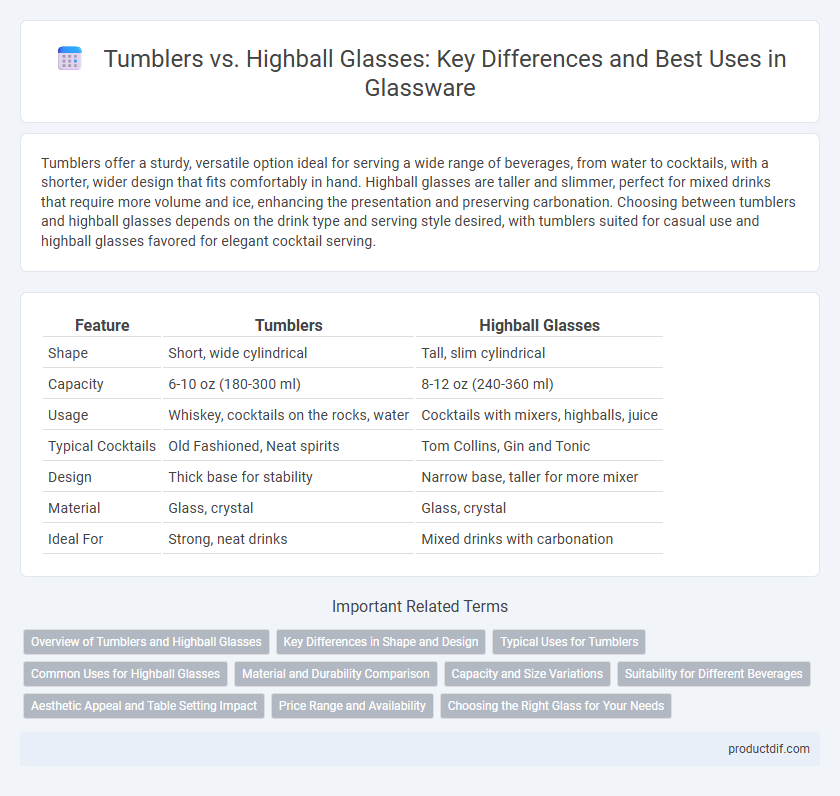Tumblers offer a sturdy, versatile option ideal for serving a wide range of beverages, from water to cocktails, with a shorter, wider design that fits comfortably in hand. Highball glasses are taller and slimmer, perfect for mixed drinks that require more volume and ice, enhancing the presentation and preserving carbonation. Choosing between tumblers and highball glasses depends on the drink type and serving style desired, with tumblers suited for casual use and highball glasses favored for elegant cocktail serving.
Table of Comparison
| Feature | Tumblers | Highball Glasses |
|---|---|---|
| Shape | Short, wide cylindrical | Tall, slim cylindrical |
| Capacity | 6-10 oz (180-300 ml) | 8-12 oz (240-360 ml) |
| Usage | Whiskey, cocktails on the rocks, water | Cocktails with mixers, highballs, juice |
| Typical Cocktails | Old Fashioned, Neat spirits | Tom Collins, Gin and Tonic |
| Design | Thick base for stability | Narrow base, taller for more mixer |
| Material | Glass, crystal | Glass, crystal |
| Ideal For | Strong, neat drinks | Mixed drinks with carbonation |
Overview of Tumblers and Highball Glasses
Tumblers are short, wide glasses typically used for serving spirits neat or on the rocks, characterized by a heavy base and no stem. Highball glasses are taller and narrower, designed to hold more volume for mixed drinks with a larger proportion of mixers like soda or juice. Both glass types enhance the presentation and experience of specific beverages by accommodating different serving sizes and drink styles.
Key Differences in Shape and Design
Tumblers feature a short, wide cylindrical shape, offering a sturdy base that suits whiskey, cocktails, or water. Highball glasses are taller and narrower, designed to enhance the presentation and mixing of carbonated cocktails like gin and tonic or rum and soda. The primary difference lies in their height and diameter, with tumblers emphasizing stability and volume control, while highball glasses focus on volume capacity and aeration.
Typical Uses for Tumblers
Tumblers are commonly used for serving a variety of beverages including water, juice, and spirits neat or on the rocks, offering versatility for both casual and formal settings. Their sturdy design and wide rim make them ideal for cocktails like Old Fashioneds and Whiskey Sours, which require muddling or ice agitation. Unlike highball glasses, tumblers are preferred for drinks that don't need a tall, narrow shape for carbonation retention or layered presentation.
Common Uses for Highball Glasses
Highball glasses are commonly used for mixed drinks that require a larger volume of liquid, such as gin and tonic, rum and coke, or a classic mojito. Their tall, slender shape accommodates plenty of ice and mixers, ensuring a balanced flavor and proper dilution. These glasses are ideal for refreshing cocktails served over ice, making them a staple in bars and home settings alike.
Material and Durability Comparison
Tumblers are typically made from thicker glass, providing enhanced durability and resistance to breakage, ideal for everyday use. Highball glasses often feature thinner glass walls, offering a more elegant appearance but less durability under frequent handling. Both materials vary between soda-lime glass and tempered glass, with tempered versions significantly improving strength and longevity in both glassware types.
Capacity and Size Variations
Tumblers typically have a capacity ranging from 8 to 12 ounces, making them ideal for serving water, juice, or cocktails in moderate portions. Highball glasses usually hold between 10 to 16 ounces, offering a taller and slimmer profile suited for mixed drinks that require more volume and ice. Size variations in tumblers and highball glasses accommodate different serving preferences, with highballs favoring larger volumes and tumblers varying more widely in style and capacity.
Suitability for Different Beverages
Tumblers are ideal for serving whiskey, neat cocktails, and everyday drinks due to their sturdy build and wide mouth, which enhances aroma and ease of sipping. Highball glasses, with their taller and slimmer design, are perfectly suited for mixed drinks like gin and tonic or soda-based cocktails that require more volume and ice. The choice between tumblers and highball glasses depends primarily on the beverage's dilution, garnish space, and presentation style.
Aesthetic Appeal and Table Setting Impact
Tumblers offer a robust, versatile aesthetic with a heavier base that complements casual and rustic table settings, enhancing the tactile experience. Highball glasses provide a sleek, elongated silhouette ideal for elegant, modern arrangements, creating visual height and sophistication on the table. Choosing between the two influences the overall ambiance, with tumblers evoking warmth and familiarity, while highball glasses elevate formality and style.
Price Range and Availability
Tumblers typically range in price from $5 to $20 per set, making them an affordable and widely available option found in most home goods stores and online retailers. Highball glasses generally cost between $10 and $30, reflecting their slightly larger size and specialized use, with availability common at specialty glassware shops and major e-commerce platforms. Both glass types are accessible in various designs and materials, catering to diverse budgets and preferences.
Choosing the Right Glass for Your Needs
Tumblers offer versatility for serving a wide range of beverages, from water to cocktails, featuring a shorter, wider shape ideal for casual use and easy handling. Highball glasses, taller and narrower, are designed to showcase mixed drinks with more ice and mixers, enhancing flavor and presentation for cocktails such as gin and tonic or rum and soda. Selecting the right glass depends on the type of drink, desired aesthetic, and practical serving needs to optimize taste and user experience.
Tumblers vs Highball Glasses Infographic

 productdif.com
productdif.com